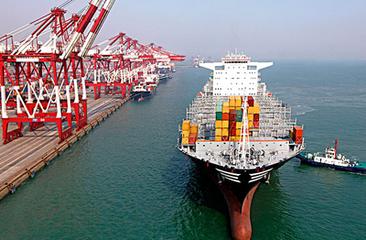Economic growth looks secure for China

In 2018, China’s trade surplus fell to 2.33 trillion yuan, showing that imports and exports are relatively balanced. Photo: FILE
Despite the unfavorable external environment, the total import and export volume of China’s goods in 2018 reached a record high by exceeding 30 trillion yuan for the first time, an increase of 9.7 percent over the previous year. Specifically, the export volume has expanded by 7.1 percent, hitting 16.42 trillion yuan, while the import volume was 14.09 trillion yuan with an increase of 12.9 percent. The country’s trade surplus has fallen to 2.33 trillion yuan, thus imports and exports are relatively balanced. In addition, China’s trade with the countries along the proposed routes of the Belt and Road has grown faster, a growth of 13.3 percent over the previous year.
This is testament to the effectiveness of the strategies in which China adjusted trade partners on its trade map for new economic cooperation and development in a timely manner. Against the backdrop of trade protectionism, the scale of China’s import and export has continued to expand, and its trade volume with major trading partners has grown. Such development displays China’s firm stance as an advocate for international economic trade based on openness, inclusiveness and cooperation.
China’s economic construction deserves praise, but we should notice that its pace of economic growth has slowed over the last four quarters from 6.8 percent to 6.4 percent. It can be said that the Chinese economy is still facing downward pressure. Although the quarterly growth rate hasn’t suffered any major decline, it reminds us to remain vigilant and double down on our efforts to ensure stable economic growth this year.
China is a big country with a vast territory, a large population and complete industrial structure. Its priority is to take care of its own business and gain the initiative in economic development. It needs to reduce the dependence on several major Western countries and balance the share of imports and exports. A more geographically diverse trade map helps to form a more balanced and rational landscape for opening up.
In 2018, the contribution of final consumption expenditure to domestic economic growth increased to 76.2 percent; domestic consumption has become a crucial driving force for economic growth. We should significantly expand domestic demand. The retail sales of the whole society in 2018 grew by 9 percent over the previous year, in which urban commodity sales increased by 8.8 percent and rural commodity sales by 10.1 percent. This indicates that the domestic market, especially the rural market, still has huge potential for development. We should strive more vigorously to expand the domestic market and stimulate the domestic consumption potential by implementing a new retail marketing approach that involves online and offline stores. China is a developing country with a huge population. We must meet the basic needs of the general public and satisfy the demands of high-end consumers. The development of consumption, the differences among consumers and their diverse capabilities for consumption have created a vast space for conducting economic construction and innovation.
In 2019, the Chinese economy is embracing a number of new economic growth poles. 5G networks are being promoted incrementally. The application of the Beidou navigation system is expanding. The Xiongan New District will begin all aspects of construction. These fields will become China’s economic vitality and momentum.
However, we need to keep a cool head. It’s not practical to pursue fast growth by lowing the quality of Chinese economy.
First, environmental standards cannot be lowered. We shouldn’t obtain growth at the expense of the environment. In 2018, the country’s environment has been significantly improved. In terms of such environmental indicators as the decreased number of air pollution days and the decreased concentration of PM2.5, the condition of China’s ecological environment, especially that of its northern cities, has been turning better. This is the initial achievement of our dedication to green development, which will tolerate no adjustment or change.
Second, we need to keep in mind that houses are built for living, not speculating. We can’t drive economic growth by causing a real estate bubble. New and innovative forms of development are needed so that houses will return to their nature as residential properties. The housing dual track system will help meet many young and middle-aged people’s demands for living and working in big cities, which will not only fill the excess capacity of steel, cement, furniture and other industries, but also solve the housing problems of many new citizens and release a strong purchasing power in the country. The goal of our work is to realize people’s yearning for a better life. The housing problem in the big cities of China has become a major contradiction that restricts people from achieving a higher sense of gain. If we can innovate and develop ideas to solve this problem, we can improve people’s living standards and stimulate market vitality, thus maintaining the stable and rapid growth of the Chinese economy in the long run.
Third, production capacity control and structural adjustment are two issues that we should stick with. In 2018, the utilization rate of national industrial capacity was only 76.5 percent, and those of the steel industry and coal industry were 78 percent and 70.6 percent respectively. These indexes remain low. Therefore, we must control production capacity, continue to reduce the production capacity of surplus industries, and activate inefficient production factors. Thus, we can boost the vitality and efficiency of economic development in the process of transformation and upgrading.
This article was translated from Guangming Daily.
(edited by MA YUHONG)
